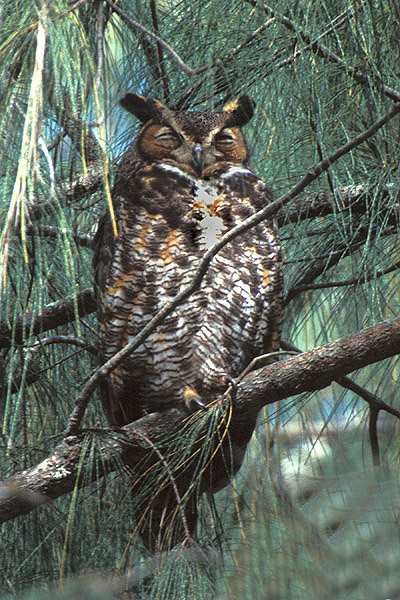 "Who-hoo-ho-oo" might not sound like much to most people, but the hoot of the Great Horned Owl means love is in the air. Valentine's Day signals that spring is on its way, with birds like the Great Horned Owl, Bald Eagle, Red-tailed Hawk, Common Raven, American Crow and Gray Jay starting to pair up and prepare for another breeding season.
"Who-hoo-ho-oo" might not sound like much to most people, but the hoot of the Great Horned Owl means love is in the air. Valentine's Day signals that spring is on its way, with birds like the Great Horned Owl, Bald Eagle, Red-tailed Hawk, Common Raven, American Crow and Gray Jay starting to pair up and prepare for another breeding season.Great Horned Owls have the distinction of being the earliest regular breeding bird in Vermont, with some pairs already sitting on eggs. They usually use old stick nests of crows, herons, and hawks, but also nest in cavities, on cliffs, in deserted buildings, and on the ground.
Most people think of owls as living deep in the forest, but Great Horneds prefer to nest near forest edges for hunting. They hunt from perches at night and are opportunistic feeders, meaning that they prey on whatever they happen to come across. Great Horneds have the most diverse diet of any owl in North America with top prey items being rabbits, mice, and waterfowl. It is the only animal that regularly preys on skunks.
The most widespread of all North American owls, Great Horneds occur across the entire continent except for northern Canada and southeastern Mexico. Within this range, they inhabit everything from tundra and forest to grassland and desert conditions, and can even be found in suburbia. They are found throughout Vermont, but are more common in the Champlain Valley and in the southern part of the state.
Great Horneds are perhaps the longest-lived owl on the continent, with one individual known to be at least 28 years old. They are the only large (46-63 cm in length), heavy (1-2.5 kg) owl with ear tufts. The familiar Barred Owl weighs in at only 0.5-1 kg and is 43-50 cm long. As is typical for raptors, the female is larger than the male; however, the male maintains a deeper voice. If you are lucky enough to hear a pair duetting this time of year, you can easily tell them apart by voice.
No comments:
Post a Comment